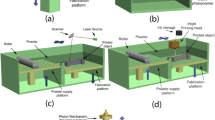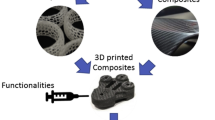Abstract
3D printing is a new processing technology, which has developed rapidly in recent years. In addition to industrial production and civil fields, it is also widely used in aerospace, military, medical, and other fields. Material used for 3D printing usually needs to have a more prominent adhesion performance to ensure a strong bonding force between multi-layer materials, so as to support the three-dimensional forming of products. Generally speaking, polymer materials such as wire, photosensitive resin, and polymer powder can be used for 3D printing. The experimental results show that the engineering plastics printed by 3D will have obvious anisotropic characteristics. It is brittle in the transverse direction and has broken before reaching the plastic stage, but it shows obvious elastic–plastic characteristics in the vertical direction. It goes through the linear elastic stage first, and then goes through the plastic softening stage.
Access this chapter
Tax calculation will be finalised at checkout
Purchases are for personal use only
Similar content being viewed by others
References
Dey, N., Mukherjee, A.: Embedded Systems and Robotics with Open Source Tools. CRC Press (2017)
Mukherjee, A., Dey, N.: Smart Computing with Open Source Platforms. CRC Press (2019)
Tang, T.M., Lu, Y.: Preparation and properties of PLA for environment-friendly 3D printing material. China Synth. Resin Plast. 32(6), 21–23 (2015)
Zhang, X.N., He, W.G.: Study on toughening modification of PLA. Plast. Sci. Technol. 41(6), 63–66 (2013)
Tang, F.L., Mo, J.H., Xue, S.L.: Study on radiation-curable composition modified by nanosilica. Polym. Mater. Sci. Eng. 23, 210–213 (2007)
Wang, C.H.: Properties of 3D printing glass fiber/thermoplastic polyurethane blended materials (in Chinese). Rubber Ind. 66(8), 596–601 (2019)
Acknowledgements
This research was financially supported by Major Natural Science Research Projects in Colleges and Universities of Jiangsu Province (17KJA430012).
Author information
Authors and Affiliations
Corresponding author
Editor information
Editors and Affiliations
Rights and permissions
Copyright information
© 2020 Springer Nature Singapore Pte Ltd.
About this paper
Cite this paper
Zhang, W., Yang, L. (2020). Study on Properties of Polymer Materials Based on 3D Printing Technology. In: Kountchev, R., Patnaik, S., Shi, J., Favorskaya, M. (eds) Advances in 3D Image and Graphics Representation, Analysis, Computing and Information Technology. Smart Innovation, Systems and Technologies, vol 180. Springer, Singapore. https://doi.org/10.1007/978-981-15-3867-4_13
Download citation
DOI: https://doi.org/10.1007/978-981-15-3867-4_13
Published:
Publisher Name: Springer, Singapore
Print ISBN: 978-981-15-3866-7
Online ISBN: 978-981-15-3867-4
eBook Packages: Intelligent Technologies and RoboticsIntelligent Technologies and Robotics (R0)




